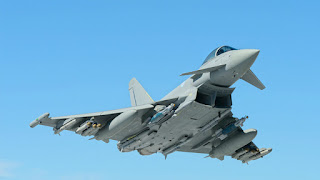HISTORY
The first flight of the prototype Eurofighter Typhoon took place on March 27, 1994, when Messerchmitt-Bülkow-Blohm (MBB) chief test pilot Peter Weger took the prototype on a test flight around Bavaria. The basic configuration is reminiscent of the British Aerospace (BAe) EAP agile combat aircraft demonstrator, which flew back in August, 1986. In fact, the EAP was used to test many Eurofighter systems before final configuration of the latter plane was decided. (The relationship is similar to the F-17 and F/A-18, where the basic planform is the same but many design changes were made.)
The EuroFighter, formerly known as the EF2000, is built by a consortium made up of BAe (UK), MBB and Dornier (Germany), Aeritalia (Italy), and CASA (Spain). It was initially designed for air-superiority and air defense roles, but a changing world situation has also resulted in an emphasis on excellent air-to-surface capabilities as well.
COCKPIT
Throughout the design process of the Eurofighter Typhoon, the needs of the single seat pilot have been paramount. This has meant high levels of attention have been paid to the control and information interfaces throughout the unique glass cockpit, from the head-up, head-down and head-out systems to all-round vision. High workload situations were analysed to establish information priorities and automate tasks.
The advanced cockpit design and layout is based on an extensive series of formal assessments in a rapid prototype facility, undertaken by operational pilots from air forces flying the Eurofighter Typhoon. Using and upgrading the advanced digital technology not only enhances operation and survivability, but also simplifies aircraft maintenance.
Other features such as Direct Voice Input (DVI) and Hands On Throttle And Stick (HOTAS) control functions have been implemented on the Eurofighter Typhoon to drastically reduce the pilot’s workload. Voice + Throttle And Stick (VTAS) enables single pilot operations even in the most demanding Air-to-Air, Air-to-Surface and swing-role missions.
ARMAMENT
As well as Short Range Air-to-Air Missiles (SRAAM’s) and the 27mm Mauser Cannon the Eurofighter Typhoon carries the latest beyond-visual-range (BVR) Air-to-Air missile technology. Soon the METEOR advanced long-range missile will provide the largest No Escape Zone of any Air-to-Air weapon, resulting in a long stand-off range and high probability of interception to ensure air superiority and pilot survivability. Guidance is provided by an active radar seeker with mid-course updates via data link.
The Laser Designator Pod (LDP) enables precise location of targets and guidance of Air-to-Surface weapons.
Eurofighter Typhoon has also been upgraded with Paveway IV to provide high levels of operational flexibility. The combat proven dual-mode guidance system, coupled with height of burst and penetrating capability, enable the decision of target engagement to be made right up to the point of release.
EUROFIGHTER TYPHOON RADAR
The Captor-M mechanically scanned radar is a best-in-class radar, offering an extensive suite of modes to meet customers’ operational requirements, as well as providing a very competitive field of regard.
The Captor-E electronically scanned radar is the future primary sensor on Eurofighter Typhoon and has a full suite of Air-to-Air and Air-to-Surface modes. The capacious aperture of the Eurofighter Typhoon allows the installation of Captor-E’s optimised and repositionable array whose field of regard is some 50 per cent wider than traditional fixed plate systems.
This wide field of regard offers significant benefits in both Air-to-Air and Air-to-Surface engagements and given the large power and aperture available provides the pilot with much enhanced angular coverage compared to fixed plate systems.
EUROFIGHTER TYPHOON PERFORMANCE
- ▪Future-oriented modular avionic and digital Flight Control System
- ▪Super-cruising, multi-role, swing-role capabilities
- ▪Ultra-modern human-machine interface: LCD screens, Hands on Throttle and Stick (HOTAS) functionalities, the Helmet Mounted Display (HMD), and Direct Voice Input
- ▪Advanced sensor data fusion and Multifunctional Information Distribution System (MIDS)
- ▪AESA radar and sensitive Infra-Red Search and Tracking system (IRST)
- ▪Extensive weapons/stores inventory on 13 hard points
- ▪Stealth features and powerful engines
- ▪Automated and mission-tailored defensive aids for high survivability.
GENERAL SPECIFICATION
| Type | Eurofighter |
| Country | Britain/Germany/Italy/Spain |
| Export | Greece/Austria |
| Function | Multi-role fighter |
| Year | 2002 |
| Crew | 1 |
| Engines | 2 * 102 kN EJ-200 reheated turbofans |
| Wing span | 10.5m (34 ft 5.5 in) |
| Length | 14.5 m (47 ft 7 in) |
| Height | 6.4 m (21 ft) |
| Wing area | 50.0 m2 (538 sq. ft) |
| Wing aspect ratio | 2.205 |
| Canard Area | 2.4 m2 |
| Tail Plane Area | N/A |
| Maximum speed | Mach 2.0 (2060 kmh, 1280 mph) |
| Maximun speed at low altitude | 1390 km/h |
| Minimum speed | 203 km/h |
| Service ceiling | 18,290m (60,000 ft) |
| Time to 10600m/Mach 1.5 | 2,5 min |
| Runway length | 500m (1,640 ft |
| Max range with max internal fuel | 600 n miles, (1112 km, 690 miles) |
| Combat Radius | 900 km |
| Ferry Range | 3700 km |
| Basic mass empty | 9,750 kg (21,495 lb.) |
| Empty Weight | 10,995 kg |
| Max take-off mass | 21,000 kg (46,218 lb.) |
| Max external stores | 6,500 kg (14,300 lb.) |
| Internal Fuel Weight | 5000 kg |
| G-limits | 9/-3.5 |









Comments
Post a Comment